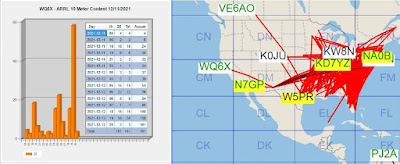I recently published a Blog about 160-meters being a world unto itself. While finishing that write-up,
in my mind, I began contrasting 160-meters (largely a nighttime band) with 10-meters, which this Blog entry is about. Aside from Daytime vs. Nighttime, the two bands are worlds apart. Paraphrasing Edgar Allen Poe "everything we see and seem is but a dream within a dream".
Tuning thru both bands, they may SEEM Dead, but only because everyone is listening an no one is transmitting. Find a CLEAR Frequency and call CQ; you may be surprised at who actually returns your call. During this years' RTTY RU and ARRL Dx Cw contests, pointing the antennas toward South America and calling CQ on a seemingly dead 10-meters brought a FLOOD of PY/PT/YV/HK/ZP stations to the Log.
With FT-2000 transceiver, there are 4 Voice Keyer memories to speak for you or send a CQ message on your behalf. Contest operating software (such as WINTEST or N1MM+) can do the same thing and even repeat-loop until your press the escape key to escape out of the sequence.
In contrast to 160-meters with its 1/2 wavelength of 260 feet, a 1/2 wave on 10-meters is only
16.2 feet. Needless to say, a -3element yagi on 10-meters is easy to achieve, whereas on 160, monstrous towers are required to accomplish anything close to the same thing.
16.2 feet. Needless to say, a -3element yagi on 10-meters is easy to achieve, whereas on 160, monstrous towers are required to accomplish anything close to the same thing.
While I go to bed with 80 & 160, I wake up to 15 & 10 meters. During sunrise and sunset,
greyline opportunities become possible, fading away almost as quickly as it comes.
greyline opportunities become possible, fading away almost as quickly as it comes.
10-meters seems to exhibit a more-or-less North-to-South propagation characteristic.
From my Northern and Southern California operating locations, it's not unusual for a plethora
of South American stations to pop in S9+ and then disappear just as quickly.
From my Northern and Southern California operating locations, it's not unusual for a plethora
of South American stations to pop in S9+ and then disappear just as quickly.
Having a 3-element Hy-Gain Long John yagi (at the Concord location) or rotatable stacked yagi
arrays (@WA6TQT in Anza) allows me to slowly "sweep the sky"; rotating the yagi(s), calling CQ, rotating another +/- 30-45 degrees and calling CQ again. When I run out of South American stations, a further clockwise antenna rotation can result in a "skip across the pond" to Hawaii, New Zealand, and Australia.
arrays (@WA6TQT in Anza) allows me to slowly "sweep the sky"; rotating the yagi(s), calling CQ, rotating another +/- 30-45 degrees and calling CQ again. When I run out of South American stations, a further clockwise antenna rotation can result in a "skip across the pond" to Hawaii, New Zealand, and Australia.
As the solar flux continues to increase, 10-meters will remain open later in the day. I fondly remember a Field Day event (the first event for W6SW atop Mt Able in South California), another operator (Peter) and I kept 10-meter Cw and Ssb (on alternate hours) alive, running frequencies
until well after 11:30pm (local time) when the band finally "went long" and faded into oblivion.
until well after 11:30pm (local time) when the band finally "went long" and faded into oblivion.
With the Solar Flux currently at 156 during recent days, I have high-hopes for a dramatic improvement
in 10-meter operating performance over coming weeks and the next few years, before we then begin
the inevitable sunspot cycle decline once again.
in 10-meter operating performance over coming weeks and the next few years, before we then begin
the inevitable sunspot cycle decline once again.
Do YOU every play around on 10-meters?
What anomalies have YOU encountered?



No comments:
Post a Comment